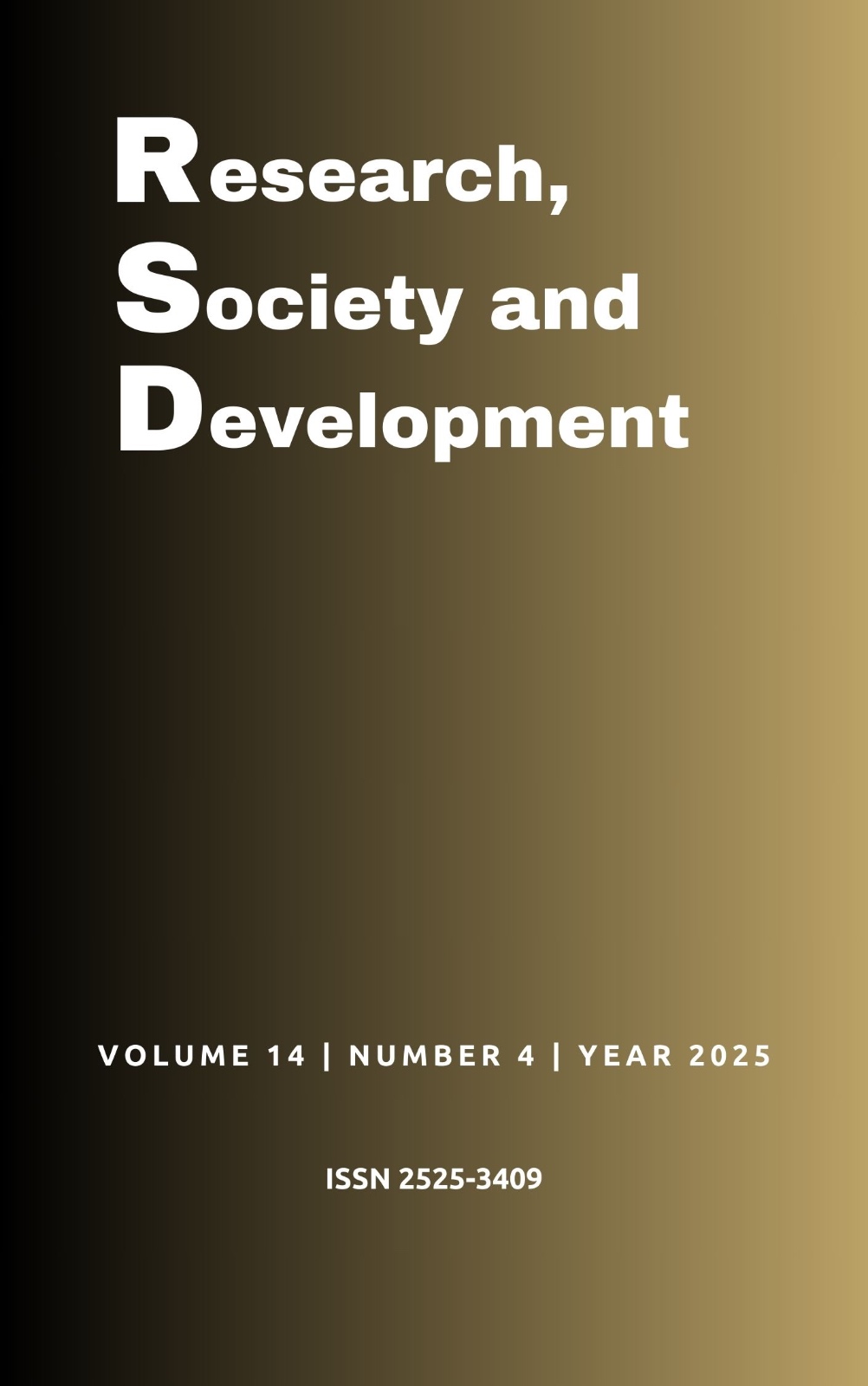Aumento vertical del borde alveolar maxilar atrófico: Una revisión bibliográfica
DOI:
https://doi.org/10.33448/rsd-v14i4.48606Palabras clave:
Implante Dental, Implante Óseo Integrado, Aumento Óseo Vertical, Cresta Alveolar.Resumen
Objetivo: La presente revisión de la literatura tuvo como objetivo evaluar las diferentes técnicas quirúrgicas para el aumento vertical del reborde alveolar en relación con la previsibilidad del aumento óseo, el riesgo de complicaciones, la tasa de éxito o fracaso de los implantes colocados, así como su tasa de supervivencia. Métodos: Se realizó una revisión narrativa de la literatura, de naturaleza cualitativa, con poca sistematización, en la cual la búsqueda de datos se llevó a cabo en las bases de datos Scientific Electronic Library Online (SciELO) y National Library of Medicine (PubMed). Resultados: Después de analizar los artículos incluídos en la revisión, los resultados de los estudios mostraron la existencia de numerosas técnicas capaces de producir uma ganancia significativa de grosor y altura del reborde alveolar em maxila.Conclusión: incluso en la evolución de numerosas técnicas quirúrgicas, la previsibilidade del aumento vertical en la cresta alveolar sigue siendo um desafio.
Referencias
Albrektsson, T., Zarb, G., Worthington, P. & Eriksson, A. R. (1986). The long-term efficacy of currently used dental implants: a review and proposed criteria of success. Int J Oral Maxillofac Implants. 1(1), 11-25.
Bianchi, A., Felice, P., Lizio, G. & Marchetti, C. (2008). Alveolar distraction osteogenesis versus inlay bone grafting in posterior mandibular atrophy: a prospective study. Oral Surg Oral Med Oral Pathol Oral Radiol Endod. 105, 282-92.
Chiapasco, M., Romeo, E., Casentini, P. & Rimondini, L. (2004). Alveolar distraction osteogenesis vs. vertical guided bone regeneration for the correction of vertically deficient edentulous ridges: a 1-3-year prospective study on humans. Clin Oral Implants Res. 15(1), 82-95.
Chiapasco, M., Zaniboni, M. & Rimondini, L. (2007). Autogenous onlay bone grafts vs. alveolar distraction osteogenesis for the correction of vertically deficient edentulous ridges: a 2-4-year prospective study on humans. Clin Oral Implants Res. 18(4), 432-40.
Dennilson, D. K., Vallone, D. R., Pinnero, G. J., RittmanI, B. & Caffesse, R. G. (1994). Differential effect of TGF-beta 1 and PDGF on proliferation of periodontal ligament cells and gingival fibroblasts.J Periodontol. 65(7), 641–8.
Esposito, M., Grusovin, M. G., Felice, P., Karatzopoulos, G., Worthington, H. V. & Coulthard, P. (2009). Interventions for replacing missing teeth: horizontal and vertical bone augmentation techniques for dental implant treatment. Cochrane Database Syst Rev. 7(4), CD003607.
Fontana, F., Santoro, F., Maiorana, C., Iezzi, G., Piattelli, A. & Simion, M. (2008). Clinical and histologic evaluation of allogeneic bone matrix versus autogenous bone chips associated with titanium-reinforced e-PTFE membrane for vertical ridge augmentation: a prospective pilot study. Int J Oral Maxillofac Implants. 23(6), 1003-12.
Huh, J. B., Park, C. K., Kim, S. E., Shim, K. M., Choi, K. H., Kim, S. J., Shim, J. S. & Shin, S. W. (2011). Alveolar ridge augmentation using anodized implants coated with Escherichia coli-derived recombinant human bone morphogenetic protein 2. Oral Surg Oral Med Oral Pathol Oral Radiol Endod. 112(1), 42-9.
Kämmerer, P. W., Palarie, V., Schiegnitz, E., Nacu, V., Draenert, F. G. & Al-Nawas, B. (2012). Influence of a collagen membrane and recombinant platelet-derived growth factor on vertical bone augmentation in implant-fixed deproteinized bovine bone – animal pilot study. Clin Oral Implants Res. 4, 1-9.
Liu, Y., Huse, R. O., de Groot, K., Buser, D. & Hunziker, E. B. (2007). Delivery mode and efficacy of bmp-2 in association with implants. J Dent Res. 86, 84–9.
Pereira A. S. et al. (2018). Metodologia da pesquisa científica. [e-book]. Editora UAB/NTE/UFSM. https://repositorio.ufsm.br/bitstream/handle/1/15824/Lic_Computacao_Metodologia-Pesquisa-Cientifica.pdf?sequence=1.
Polo, C. I., Oliveira Lima, J. L., De Lucca, L., Piacezzi, C. B., Naclério-Homem, M. D., Arana-Chavez, V. E. & Sendyk, W. R. (2013). Effect of Recombinant Human Bone Morphogenetic Protein 2 Associated with a Variety of Bone Substitutes on Vertical Guided Bone Regeneration in Rabbit Calvarium. J Periodontol. 84(3), 360-70. doi: 10.1902/jop.2012.110674. https://pubmed.ncbi.nlm.nih.gov/22524330/.
Rocchietta, I., Fontana, F. & Simion, M. (2008). Clinical outcomes of vertical bone augmentation to enable dental implant placement: a systematic review. J Clin Periodontol. 35(8 Suppl), 203-15.
Roccuzzo, M., Ramieri, G., Bunino, M. & Berrone, S. (2007). Autogenous bone graft alone or associated with titanium mesh for vertical alveolar ridge augmentation: a controlled clinical trial. Clin Oral Implants Res. 18(3), 286-94.
Hollinger, J. O., Hart, C. E. & Hirsch, S. N. (2008). Recombinant human plateletderived growth factor: biology and clinical applications. J Bone Joint SurgAm. 90(suppl 1), 48–54.
Scarano, A., Assenza, B., Di Cerbo, A., Candotto, V., Santos De Oliveira, P. & Lorusso, F. (2017). Bone regeneration in aesthetic areas using titanium micromesh. Three case reports. Oral Implantol (Rome). 10(4), 488-94.
Seibert, J. S. (1983). Reconstruction of deformed, partially edentulous ridges, using full thickness onlay grafts. Part II. Prosthetic/periodontal interrelationships. Compend Contin Educ Dent. 4(6), 549-62.
Descargas
Publicado
Número
Sección
Licencia
Derechos de autor 2025 Daniel Falleiro Simundi; Laiza Naiara Schmitz Simundi

Esta obra está bajo una licencia internacional Creative Commons Atribución 4.0.
Los autores que publican en esta revista concuerdan con los siguientes términos:
1) Los autores mantienen los derechos de autor y conceden a la revista el derecho de primera publicación, con el trabajo simultáneamente licenciado bajo la Licencia Creative Commons Attribution que permite el compartir el trabajo con reconocimiento de la autoría y publicación inicial en esta revista.
2) Los autores tienen autorización para asumir contratos adicionales por separado, para distribución no exclusiva de la versión del trabajo publicada en esta revista (por ejemplo, publicar en repositorio institucional o como capítulo de libro), con reconocimiento de autoría y publicación inicial en esta revista.
3) Los autores tienen permiso y son estimulados a publicar y distribuir su trabajo en línea (por ejemplo, en repositorios institucionales o en su página personal) a cualquier punto antes o durante el proceso editorial, ya que esto puede generar cambios productivos, así como aumentar el impacto y la cita del trabajo publicado.


